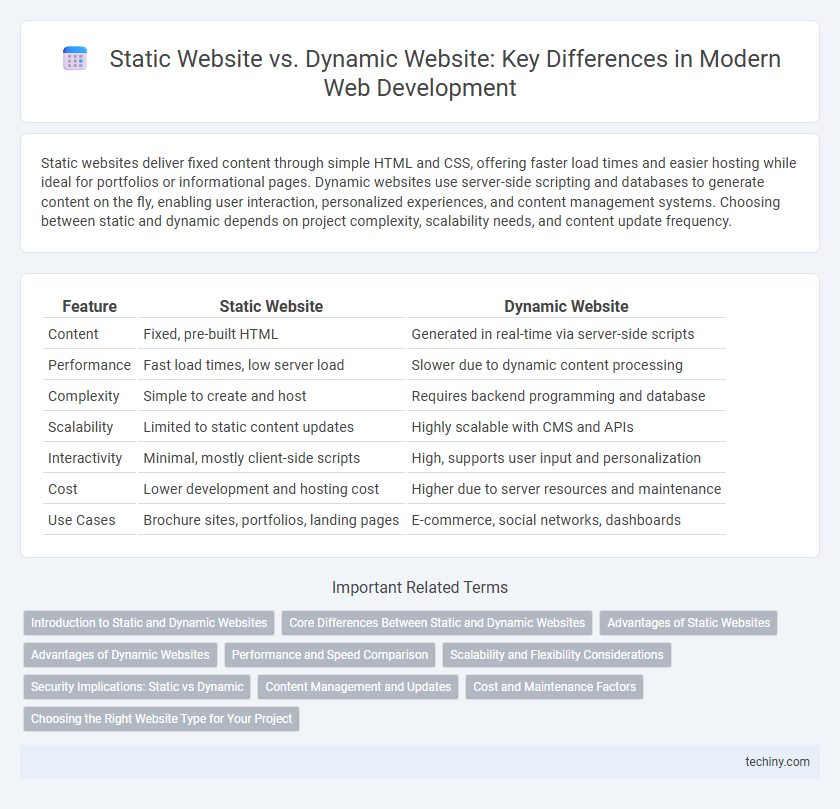Static websites deliver fixed content through simple HTML and CSS, offering faster load times and easier hosting while ideal for portfolios or informational pages. Dynamic websites use server-side scripting and databases to generate content on the fly, enabling user interaction, personalized experiences, and content management systems. Choosing between static and dynamic depends on project complexity, scalability needs, and content update frequency.
Table of Comparison
| Feature | Static Website | Dynamic Website |
|---|---|---|
| Content | Fixed, pre-built HTML | Generated in real-time via server-side scripts |
| Performance | Fast load times, low server load | Slower due to dynamic content processing |
| Complexity | Simple to create and host | Requires backend programming and database |
| Scalability | Limited to static content updates | Highly scalable with CMS and APIs |
| Interactivity | Minimal, mostly client-side scripts | High, supports user input and personalization |
| Cost | Lower development and hosting cost | Higher due to server resources and maintenance |
| Use Cases | Brochure sites, portfolios, landing pages | E-commerce, social networks, dashboards |
Introduction to Static and Dynamic Websites
Static websites consist of fixed web pages coded in HTML and CSS, delivering the same content to every user without server-side processing. Dynamic websites use server-side scripting languages such as PHP, ASP.NET, or JavaScript frameworks to generate personalized content based on user interactions or database queries. Choosing between static and dynamic architecture depends on the project's scale, content update frequency, and user engagement needs.
Core Differences Between Static and Dynamic Websites
Static websites consist of fixed content delivered directly to the browser, making them faster to load and easier to host with minimal server resources. Dynamic websites generate content in real-time using server-side scripting languages like PHP, Python, or JavaScript frameworks, enabling personalized and interactive user experiences. Core differences include content management, scalability, and user interaction, with dynamic sites supporting database integration and content updates without altering the underlying code.
Advantages of Static Websites
Static websites offer faster loading speeds due to pre-rendered HTML, which reduces server processing time and improves user experience. They provide enhanced security since static files have fewer vulnerabilities compared to databases and server-side scripts typical of dynamic websites. Maintenance is simpler and cost-effective because updates involve straightforward file edits without the need for complex backend management or software updates.
Advantages of Dynamic Websites
Dynamic websites offer enhanced user engagement by delivering personalized content based on user behavior and preferences. They facilitate easier content management through integrated content management systems (CMS) like WordPress or Drupal, enabling real-time updates without requiring extensive coding knowledge. Additionally, dynamic websites support interactive features such as user login, e-commerce functionality, and data-driven applications, improving overall site functionality and user experience.
Performance and Speed Comparison
Static websites deliver faster load times and superior performance by serving pre-rendered HTML files directly from the server, reducing server processing and database queries. Dynamic websites generate content in real-time using server-side scripting languages like PHP or Node.js, which can slow performance due to continuous server and database interaction. Optimizing caching mechanisms and minimizing database calls in dynamic sites can partially narrow the speed gap but generally static sites maintain an edge in raw performance metrics.
Scalability and Flexibility Considerations
Static websites offer limited scalability and flexibility, as their content is fixed and requires manual updates for changes. Dynamic websites excel in scalability by allowing real-time content management and user interaction through databases and server-side scripting. Flexibility is significantly higher in dynamic sites, enabling personalized user experiences and seamless integration with various APIs and third-party services.
Security Implications: Static vs Dynamic
Static websites present fewer security risks because they serve fixed content without server-side processing, reducing vulnerabilities like SQL injection or cross-site scripting. Dynamic websites rely on server-side code and databases, increasing exposure to attacks such as code injection, data breaches, and unauthorized access. Implementing robust security measures like input validation, regular patching, and web application firewalls is crucial for dynamic sites to mitigate these risks effectively.
Content Management and Updates
Static websites deliver fixed content stored in HTML files, making updates time-consuming and requiring manual coding. Dynamic websites leverage server-side technologies and databases, enabling real-time content management systems (CMS) for easy, automated updates. CMS platforms like WordPress or Joomla streamline content editing, version control, and user permissions, enhancing efficiency in maintaining dynamic websites.
Cost and Maintenance Factors
Static websites typically incur lower initial development costs and require minimal maintenance since their content rarely changes, making them ideal for small businesses with limited budgets. Dynamic websites involve higher upfront expenses due to complex backend development and ongoing maintenance to manage databases, user interactions, and frequent content updates. Choosing between static and dynamic sites depends on budget constraints and the need for scalability, interactivity, and regular content management.
Choosing the Right Website Type for Your Project
Static websites offer fast loading times and enhanced security by delivering pre-rendered HTML pages directly to users, making them ideal for small portfolios or informational sites with limited content updates. Dynamic websites generate content in real-time using server-side scripting languages like PHP, Python, or JavaScript frameworks, suitable for e-commerce platforms, blogs, or applications requiring frequent updates and user interaction. Selecting the right website type depends on project goals, scalability needs, content management preferences, and anticipated traffic volume.
Static Website vs Dynamic Website Infographic

 techiny.com
techiny.com